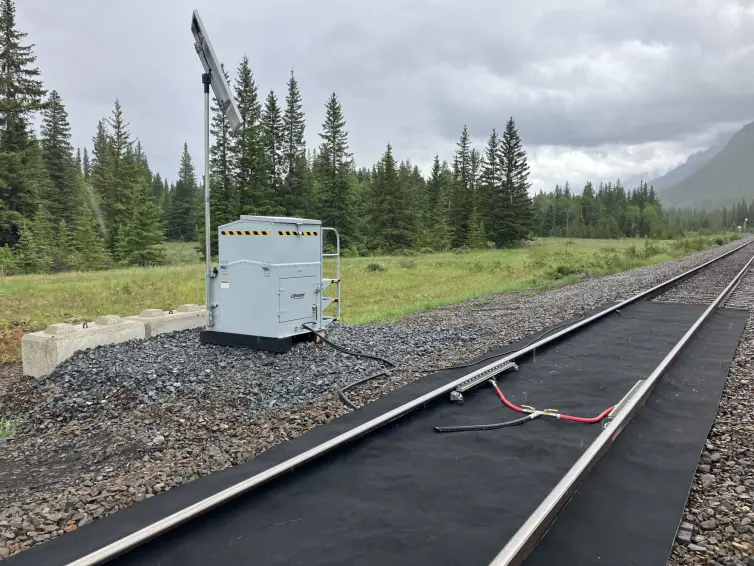Heavy conveyor solution
- Sep 02, 2021
- Rail
A manufacturer of high-performance diesel engines approached L.B. Foster when they were designing the manufacturing process for their new engine. The new line would be a new concept to the manufacturer where operators would work in assembly cells surrounding the engine.
The new conveyor helps operators in the assembly of the engines. Operators work on both sides of the engine, which requires a change in height of the conveyor to support the assembly of the engines at two of its 13 operator stations.
L.B. Foster Automation & Materials Handling submitted detailed project designs, which were successfully selected by the client. We applied our many years of expertise in the design, installation and commissioning of heavy duty materials handling and automated manufacturing solutions.
Requirement
Assembling large engines on the move requires a clear understanding of the scope of the project - from conveyor and turntable loading to workstation layout, ergonomics and health and safety considerations.
The 12 station L-shaped engine assembly line for a manufacturer of high-performance diesel engines encompassed a complex requirement to move part-assembled engines on a series of conveyors and turntables through each work station.
Work stations needed to be designed to maximise working efficiencies, identifying the particular engine specification via a RFID reader and automatically configuring tooling at the station to the correct settings, whilst ensuring operator safety and comfort.
“The great thing about working with L.B. Foster is the willingness of the team to collaborate and improve upon the initial design. That shows their knowledge and expertise, as well as the confidence to guide us towards an even better end working product.“
Scope
Manual assembly station
The design of the new semi-automated engine manufacturing line incorporates 12 manual assembly stations. At each assembly station, individual operators add different engine components to the part preassembled engine.
An important part of the project’s health and safety specification requires each operator’s workstation to be ergonomically designed. This minimises any need for operators to over strain during the assembly process. The workstation also increases efficiency and quality with tooling automatically setting its self to the engine type being assembled, with all necessary components accommodated on the work station.
Work platform
The work platform sits 150mm lower than the top of the system’s platern. Each station features anti-wear and anti-fatigue matting. The working platform is made of fabricated steel and painted. Work stations feature steps on the non-working side of the conveyor to allow for access both on the inside and outside of the conveyor loop. Platerns are designed with wheeled edges to remove any risk of crabbing.
Lift stations
Two scissor lifts are included in the layout, featuring the conveyor section on top. Each lift has manual controls that allow operators to adjust the height to a comfortable working height.
Conveyor
The conveyor system comprises custom rollers plus a walkover plate. The plate allows operators to safely walk over the conveyor when the assembly process is in action.
Two conveyor sections make up each work station. Two sections are driven by two individual motors and gearboxes. The conveyor sections are chain driven rollers. The friction coefficient and contact surface of the shaft couplings is designed to ensure the smooth running of all variants of engine/pallet.
Anti-fatigue matting is used in the top of the treadplate where operators walk around the engine. Physical Blade stops are placed on every stop and pre stop to help position the platen when work is being carried out.
Stack light
All work stations are fitted with a stack light to alert supervisors to issues with the assembly. The system also alerts the operators when the system is ready to move on.
Floor scanners
Floor scanners continually monitoring floor around the engine to ensure staff are clear and automatically adjust to the size of the engine.
Feasibility study
Prior to being awarded the full project contract, L.B. Foster’s design engineers worked in partnership with the client to develop a project feasibility study. This enabled us to improve upon the client’s original project design and specification.
As part of the feasibility study we designed and built a ‘proof of concept’. We used this to demonstrate to the client the capability of the conveyor. The proof of concept solution was successfully tested over a six week period at L.B. Foster’s Automation Centre of Excellence in Nottingham.
The feasibility study fee was absorbed into the overall project fee, providing best value to the client.
What they said
“This was all about collaborating to achieve the best possible solution - both mechnically and for the welfare and wellbeing of our operators. The ‘proof of concept’ model that L.B. Foster’s team developed sealed the project for us as it showed in real-time the benefits of the conveyor and workstation solution.“
Our solution
13 manual assembly stations
32 x 2.1m conveyor sections (wide edge leading)
15 x 2.1m conveyor sections (narrow edge leading)
2 x 90 degree corner transfers
5 x turntable units.
27 x RFID read write units – Stop and Pre-Stop + 1 for orientation turntable
30 x RFID Tags
30 x platens to standardise the shipping pallet sizes
1 x 15 in full-colour HMI unit
2 x scissor lifts (rise of 800mm) with manual operator control
2 x team lead station
Integration of the complete system

